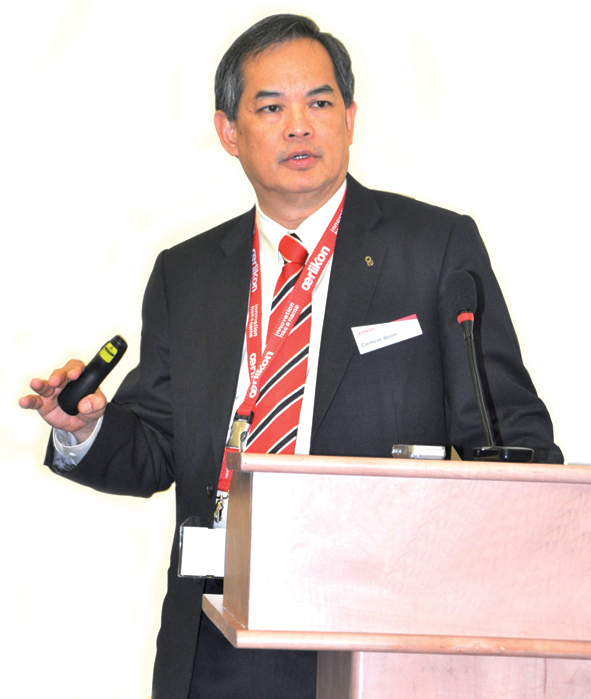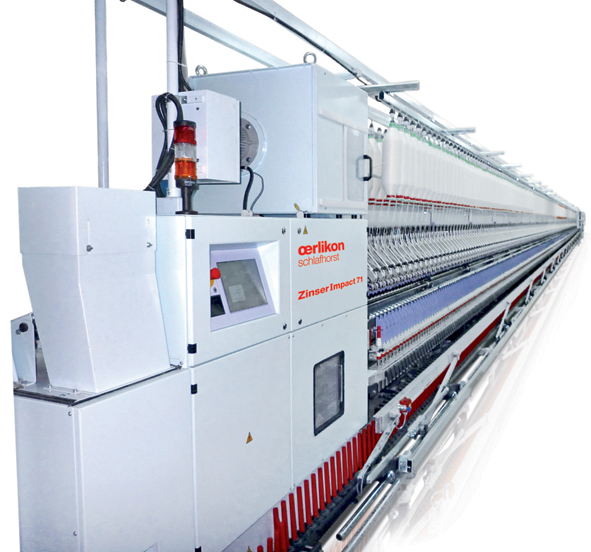– Clement Woon
 Oerlikon Textile is a leading high-tech industrial group specializing in machine and plant engineering. The Swiss company is a provider of innovative industrial solutions and cutting-edge technologies for textile manufacturing, drive, vacuum, thin film, coating, and advanced nanotechnology. With a tradition going back over 100 years, the company is a global player with more than 17,000 employees at over 150 locations in 38 countries and sales of CHF 4.2 billion in 2011.
Oerlikon Textile is a leading high-tech industrial group specializing in machine and plant engineering. The Swiss company is a provider of innovative industrial solutions and cutting-edge technologies for textile manufacturing, drive, vacuum, thin film, coating, and advanced nanotechnology. With a tradition going back over 100 years, the company is a global player with more than 17,000 employees at over 150 locations in 38 countries and sales of CHF 4.2 billion in 2011.
At ITMA Asia 2012, Oerlikon Textile showcased the ZinserImpact 71, a ring spinning machine specially developed for the mid-range segment in China. As well as giving his assessment of this new development, Mr. Clement Woon, CEO of the company, discussed in an interview to The Textile Magazine why China’s textile industry and Oerlikon Textile are increasingly benefiting each other, as well as China’s move towards automation and sustainability.
Excerpts from the interview:
Question: What are the main areas of focus for Oerlikon Textile at ITMA Asia 2012?
Answer: We showcase leading technological solutions from our five brands in the areas of man-made fibres, natural fibres and textile components for the requirements of the Asian and, in particular, the Chinese market. Our specific areas of focus are sustainable textile production and our e-save programme, which started in 2004. Our certified machines are more productive, save more energy and gentle to the environment by producing less waste than comparable products. At ITMA Asia we are therefore again offering people the opportunity to investigate our technological world in detail. All visitors were also warmly invited to our “virtual showroom” where they could explore complex installations and processes for non-wovens, synthetic staple fibres and BCF carpet yarn plants in 3D presentations.
 Q: Can you give us some examples of the e-save improvements?
Q: Can you give us some examples of the e-save improvements?
A: For example, our Autocoro 8 rotor spinning machine, which we presented last year at ITMA Barcelona, gives a higher productivity of up to 25% or more compared to its predecessors and to the current competitor models. And I think we can safely say that our Allma CC4 two-for-one twisting machine is revolutionising the market in tyre cord cabling, achieving energy savings of up to 50%. And our FDY-WINGS filament winding machine shows its class in three areas: It gives energy savings of around 25%; it only requires half the footprint; and it helps spinning mills save on handling and even personnel, thanks to a new more ergonomic, compact design.
These are just a few of many examples in our product range that offer our customers optimum performance in terms of economic and, particularly, environmental aspects. We do not see sustainability as a stumbling block, but as a pacemaker for innovative technological advance.
Q: Does this also apply to your activities in the Chinese market?
A: Absolutely. As you’ll certainly be aware, the 12th Five-Year Plan passed by the Chinese Government particularly promotes automation and the achievement of higher quality in textile production. Environmental improvements and a reduction in labour and energy costs are also key themes. If you consider our portfolio and its strengths against this background, it is immediately evident that Oerlikon Textile has the right answers to the questions and requirements of the Chinese textile industry of today and tomorrow.
We can benefit greatly from each other as since 2004 our development and manufacturing processes have been based on our self-imposed e-save philosophy. Here we focus on higher energy efficiency, improved machine effectiveness and productivity, reduced environmental impact and better ergonomic design which has had effects, e.g., in the areas of handling and noise reduction.
Q: How strongly is Oerlikon Textile positioned in China?
A: Our activities here go back to the 1960s. China is today our main target market. We have sites in Shanghai, Suzhou, Beijing, Wuxi, Jintan, Urumqi and Zhengzhou with a total of almost 2,000 employees. In 2011 our sales reached nearly 1 billion Swiss francs, which is almost 50% of our sales in the Oerlikon Textile Group. The importance of this market is also reflected in the fact that part of our management team now operates out of Shanghai. We are represented with all five brands and therefore offer our complete product range in China with total solutions for yarn manufacturing. And we’re coming to ITMA Asia with a brand-new machine that should be extremely interesting for the Chinese market.
Q: Can you tell us a bit more about this?
A: Oerlikon Textile’s products are primarily positioned in the automated high-end segment. Now, following the Zinser 360 we are entering the mid-range market more strongly with the ZinserImpact71. Our new machine is suitable for a wide range of raw materials and yarn titres and can be set quickly and easily when switching yarn qualities. The system is a self-cleaning compact system for constant and reliable yarn quality. Machine control and engineering are designed for low personnel input, low energy consumption and low maintenance as well as high productivity and fewer machine downtimes as a result of yarn breaks or twist. These are all arguments that are received well in China.
Q: What are your hopes for the machine and the development of the mid-range segment?
A: We have already gained useful experience in the lower high-end segment over the past few years in various technology sectors. In rotor spinning we have achieved great sales success in the past two years with the semi-automatic BD series, which is manufactured in China. With the new ZinserImpact 71, we are therefore confident of going straight to the heart of the market and offering a product that has a future in China. Particularly in the spinning mill sector, Oerlikon Textile continues to be a trend-setter and innovation leader with new products.
Q: You have been CEO of Oerlikon Textile since the beginning of 2012. What are your main areas of focus for taking the business forward?
A: The textile industry is a challenging industry. Firstly, the coverage of textile machinery is very wide. The value chain from raw material to the final product is long. Secondly, it is dynamic and subjected to many factors. Thirdly, it is an important industry that provides needed jobs, especially in emerging countries. My focus is therefore on the strategy of our company to be more customer focused, more responsive to the dynamics of industry and more innovative in terms of our enterprise and products. To shape the future, we need to continuously build capabilities, across the entire management team.